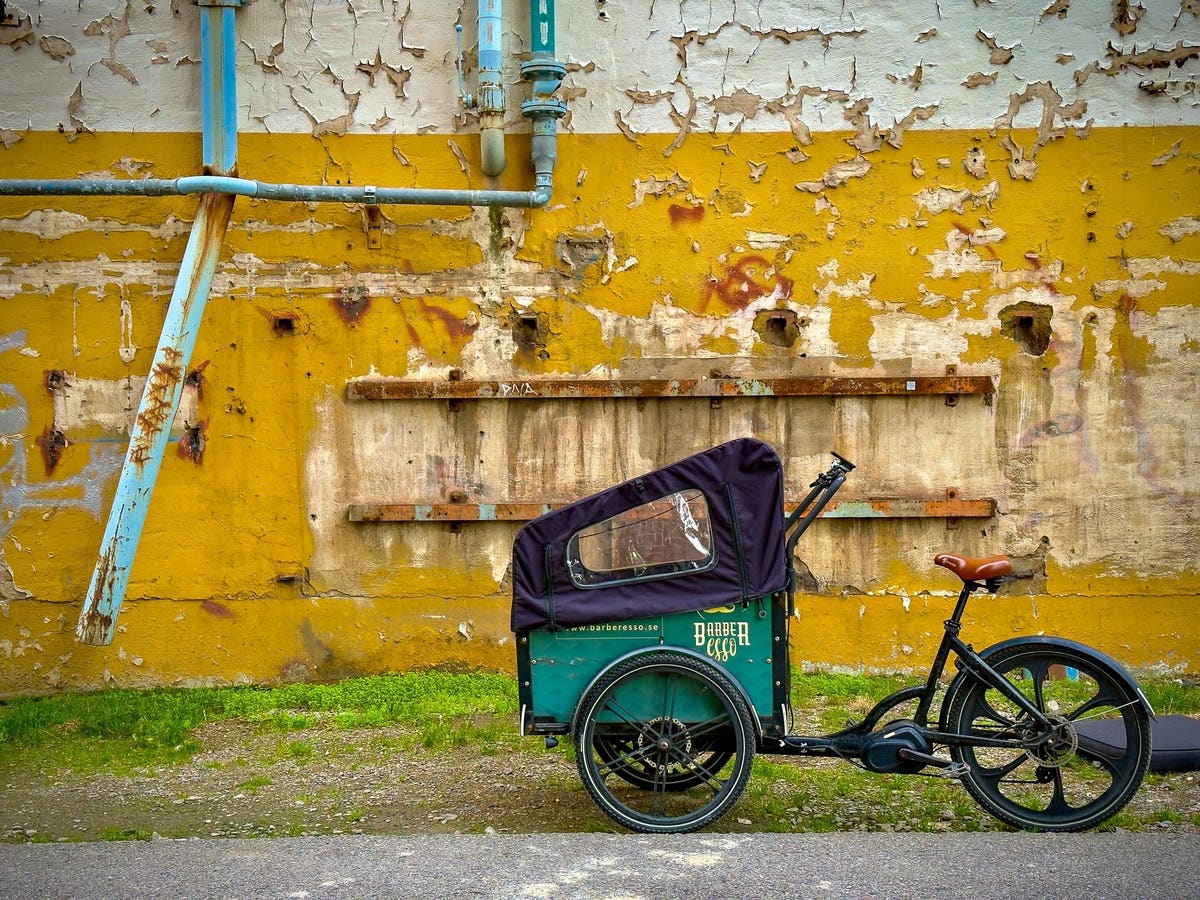Cargobike in the Varvsstaden district of Malmö, Sweden.
Carlton Reid
The seat benches outside Oatly’s swankily sustainable HQ in Malmö, Sweden, are upcycled from girders. Not the metaphoric steel beams jokingly marketed as the main ingredient of Scottish drink brand Irn Bru, but actual girders. The girders were sourced from a databank of materials rescued, stored, and listed online by Varvsstaden AB, the urban regeneration developer in charge of reshaping the city’s Varvsstaden district, a historic former shipyard that closed in stages throughout the 1980s and 1990s.
Stockholm-listed real estate company Balder and construction company PEAB own the development company, a previous incarnation of which bought the 190,000-square-meter former shipyard in 2005, later levelling what couldn’t be saved while retaining nine historic brick structures, including the Gjuteriet building, now home to Oatly.
Reclaimed girders repurposed as seat benches outside the Oatly HQ in Varvsstaden district of Malmö, Sweden.
Carlton Reid
The alt-dairy heavyweight’s “new” HQ was fashioned from reclaimed materials and erected in the shell of a former foundry dating to 1910. Restored by architecture firm Kjellander Sjöberg, the building’s partially ruined exterior walls were reimagined with reclaimed bricks sourced from nearby demolished buildings, and stored in a still-standing warehouse that houses Varvsstaden AB’s “Materialbanken,” a collection of reclaimed materials, with every corrugated panel, light fitting, and heritage brick searchable in an online database. Architects working on the regeneration project can use the digital Materialbanken to locate resources for upcycling.
One of Varvsstaden’s nine rescued brick buildings with, in the background, Malmö’s “Turning Torso” residential skyscraper designed by Spanish architect, structural engineer, sculptor and painter Santiago Calatrava opened in 2005.
Carlton Reid
Oatly’s HQ—veined with reclaimed woodern beams and dressed with genuinely distressed artefacts—is open to the public, housing a coffee shop serving the double-fat barista blend Oatly, the hero product that, after a major rebrand, helped the Swedish oat milk brand expand globally. Oatly’s distinctive environmentally-centered marketing and packaging copy—“wow, no cow” and “Milk, but made for humans”—is provocative, especially to “big dairy.”
Oatly packaging are seen in a store in New York City, United States on July 15, 2024. (Photo by Jakub Porzycki/NurPhoto via Getty Images)
NurPhoto via Getty Images
Oatly’s sustainability plan qualified it as the world’s first food brand to become an official climate solutions company, reported Vegconomist.com—bolstering its eco messaging by headquartering in an upcycled building made perfect sense.
Oatly is part-owned by The Blackstone Group, Verlinvest, via Nativus Company Limited a part of China Resources (a conglomerate owned by the Chinese state), Industrifonden, Östersjöstiftelsen, and employees. Shareholders also include celebrities such as Oprah Winfrey and Jay-Z, as well as Starbucks founder Howard Schultz.
Probably
Cheekily adapting the marketing slogan of a particular beer brand made in Copenhagen, 32 miles away across the Oresund Bridge, Varvsstaden AB comms manager Elin Fasth said on a site tour: “Varvsstaden is probably the most exciting neighborhood in the world.”
Pointing to the Gjuteriet building, she said Oatly was a perfect fit for Varvsstaden, which is aiming to be a dockside regeneration project that’s as sustainable as possible and distinctive and memorable.
Thule’s new corporate HQ in Malmö’s Docken district, adjacent to the former shipyard of Varvsstaden.
Carlton Reid
Other businesses nearby and part of the adjacent quay, dry dock, and inner basin include the new corporate HQ for Swedish car racks to luggage brand Thule. Soon to relocate to the area is an offshoot of Lund University, which is appropriate given that the original recipe for Oatly sprang from research carried out by academics from the institution.
For more than a hundred years, and when it was still churning out ships and submarines, Varvsstaden was not accessible to the public but thanks to three new pedestrian and cyclist bridges, it is now connected to other parts of Sweden’s third-largest city. The mixed redevelopment project, when completed, will consist of 2,500 new homes, several schools and kindergartens, green spaces, and many more businesses, said Fasth.
Girders turned into playground equipment in Malmö’s Varvsstaden district, a former shipyard.
Carlton Reid
Several shipyard superstructures have been left in place, towering over toddler swings suspended from reclaimed girders.
“Not all of the steel products stored in the Materialbanken are strong enough to be used in buildings today, so they are upcycled into benches and other things,” said Fasth, pointing to the seat benches outside Oatly’s HQ.
Shipyard superstructure left in situ in Malmö’s Varvsstaden district.
Carlton Reid
Varvsstaden AB is based in one of the oldest buildings on the site, which was first developed in 1871, the year after Frans Henrik Kockum, the founder of Kockums Shipyard, bought the area. Fasth said the building’s foundations were sinking into the sea, so the historic structure was jacked up by a metre, and thereby saved.
Spiral staircase waiting to be reused in Varvsstaden’s “Materialbanken.”
Carlton Reid
Wandering into a nearby warehouse, I spotted girders that may be upcycled into benches sometime soon. There was also a spiral staircase that would look great in a future corporate HQ for a brand that, Oatly-style, may also choose to lean into the circular economy.
Varvsstaden AB—which measures the amount of CO2 emissions saved through the extensive use of the shipyard’s historic materials, data shared transparently on the company’s website—estimates that 80% of the rescued building materials and industrial artefacts in the Materialbanken will be reused on the project, due to be completed in 2041.
